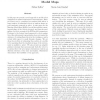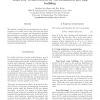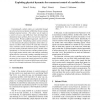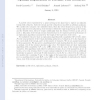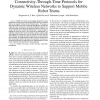121
Voted
ICRA
2002
IEEE
15 years 5 months ago
2002
IEEE
In this paper we present a novel approach to mobile robot navigation in natural unstructured environments. Natural scenes can be considered as random fields where a large number ...
54
Voted
ICRA
2002
IEEE
15 years 5 months ago
2002
IEEE
: In this paper, mobility analysis of various planar mobile robots are performed. Two different approaches are employed for that purpose. In the first approach, joint screws are em...
109
click to vote
ICRA
2002
IEEE
15 years 5 months ago
2002
IEEE
We describe a method for the reconstruction of a driven trajectory of a mobile robot if the begin and end states of the trajectory are known, and intermediate readings from odomet...
85
Voted
ICRA
2002
IEEE
15 years 5 months ago
2002
IEEE
Conventionally, mobile robots are controlled through an action selection mechanism (ASM) that chooses among multiple proposed actions. This choice can be made in a variety of ways...
115
click to vote
ICRA
2002
IEEE
15 years 5 months ago
2002
IEEE
In this paper we present a system for topologically localizing a mobile robot using color histogram matching of omnidirectional images. The system is intended for use as a navigat...
112
click to vote
ICRA
2002
IEEE
15 years 5 months ago
2002
IEEE
—This article describes a rigorous and complete framework for the simultaneous localization and map building problem for mobile robots: the symmetries and perturbations map (SPma...
100
Voted
SWAT
2010
Springer
15 years 5 months ago
2010
Springer
A mobile robot represented by a point moving in the plane has to explore an unknown terrain with obstacles. Both the terrain and the obstacles are modeled as arbitrary polygons. W...
104
click to vote
IDA
2003
Springer
15 years 5 months ago
2003
Springer
For a mobile robot to act autonomously, it must be able to construct a model of its interaction with the environment. Oates et al. developed an unsupervised learning method that pr...
110
Voted
ICRA
2003
IEEE
15 years 6 months ago
2003
IEEE
Abstract— This paper addresses the problem of localization and map construction by a mobile robot in an indoor environment. Instead of trying to build high-fidelity geometric ma...
101
Voted
ICRA
2003
IEEE
15 years 6 months ago
2003
IEEE
—Mobile robot teams are increasingly deployed in various applications involving remote operations in unstructured environments that do not support wireless network infrastructure...
